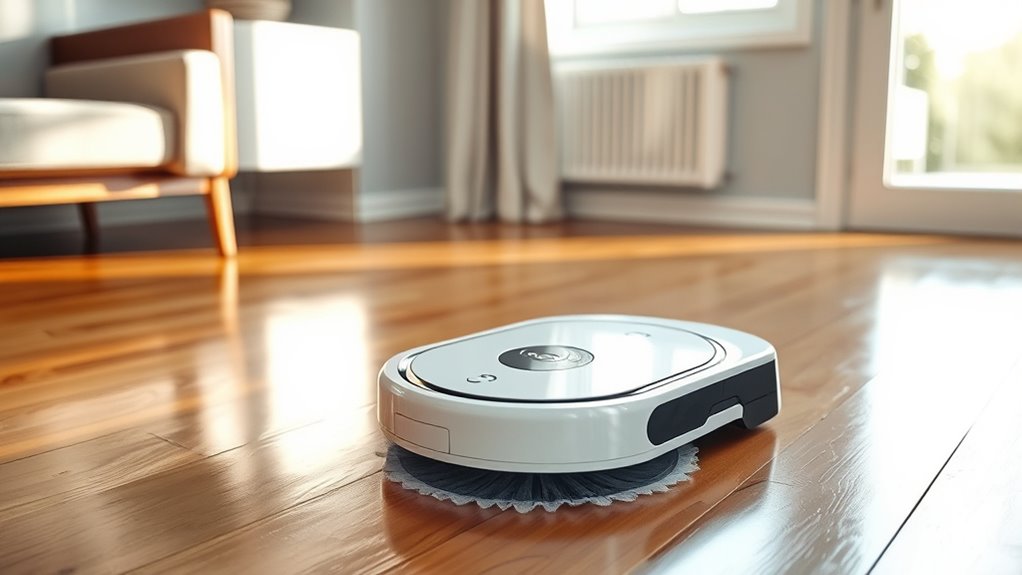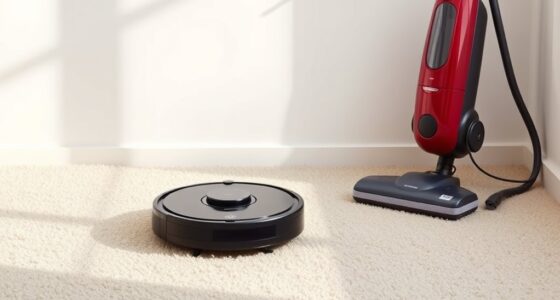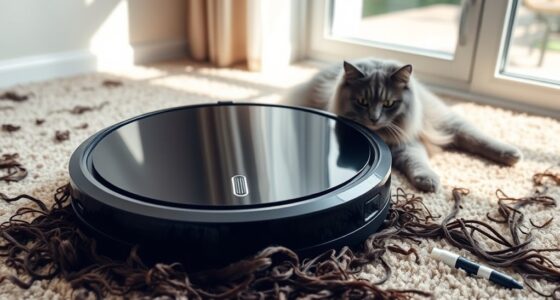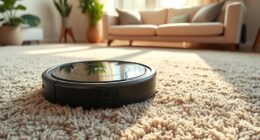Robot mops not only clean floors efficiently but also incorporate features like UV-C sterilization, disinfectant dispensing, and targeted scrubbing to help reduce bacteria and viruses. Advanced sensors guide them to sanitize thoroughly, often surpassing manual cleaning in speed and consistency. However, their effectiveness depends on the models and features chosen, as some may have limited sanitization capabilities or struggle with tough stains. If you want to explore how these devices truly sanitize your floors, keep exploring further.
Key Takeaways
- Many robot mops incorporate UV-C sterilization to kill bacteria and viruses on floors.
- Advanced models use sensors and targeted cleaning to improve overall sanitation effectiveness.
- Proper water tank maintenance and cleaning features prevent bacterial buildup and ensure hygiene.
- While effective at removing dirt, robot mops may not fully disinfect surfaces without additional sanitization methods.
- Future innovations like self-cleaning mop pads aim to enhance overall floor sanitation and hygiene.
How Do Robot Mops Clean and Sanitize Floors?
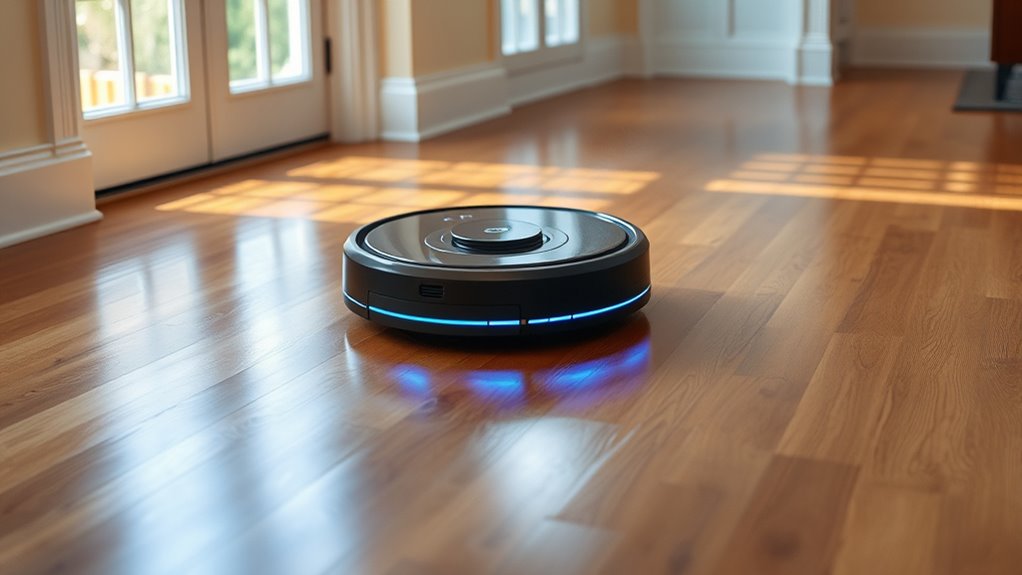
Robot mops clean and sanitize floors by combining water, cleaning solutions, and mechanical action. They use water tanks and mop pads that may oscillate, rotate, or vibrate to physically scrub the surface and loosen dirt. Water is dispensed onto the floor or directly onto the mop pad to dissolve grime and stains. After scrubbing, some models wipe away the loosened dirt with suction or absorb it into the mop pads. The cleaning cycle typically involves wet mopping followed by dry wiping to leave floors cleaner. Advanced robot mops feature separate clean and dirty water tanks, automatically wash mop pads with hot water, and monitor water quality. Sensors help regulate water flow and assess dirt levels, ensuring thorough cleaning without over-wetting or spreading dirt. These systems are designed to optimize cleaning efficiency and hygiene by continuously adjusting water usage based on floor conditions. Additionally, some models incorporate privacy considerations by managing how data from sensors is utilized or stored during cleaning cycles.
Technologies Enhancing Robotic Sanitization
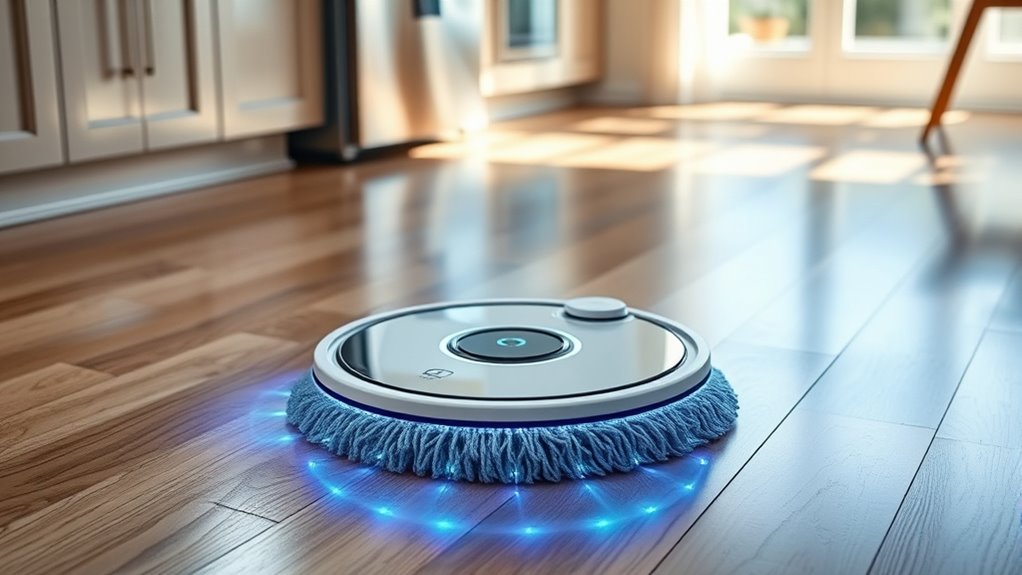
Advancements in sensor and navigation technologies substantially boost the sanitization capabilities of robotic cleaning devices. These innovations enable robots to detect obstacles, map rooms accurately, and adapt their cleaning routes in real time. Enhanced sensors like ToF, infrared, and laser improve obstacle avoidance and floor coverage. Dirt and stain detection sensors enable targeted cleaning of heavily soiled areas. Some models combine UV-C light sterilization to kill bacteria and viruses during operation. Multi-pad spinning systems and adjustable water flow optimize scrubbing and sanitizing, while large tanks and quiet motors support extended, discreet cleaning sessions. Incorporating Honda Tuning technologies, such as upgraded sensor systems, further enhances the precision and efficiency of robotic mops.
Comparing Robot Mops to Manual Cleaning

When comparing robot mops to manual cleaning, you’ll notice that robots can cover floors faster and with more consistency. They also remove contaminants more effectively, thanks to programmed patterns and sensors that guarantee thorough sanitation. This means less missed spots and a higher standard of cleanliness overall. Robot mops’ ability to operate autonomously allows them to perform cleaning tasks even when you’re not present, further enhancing their efficiency. Additionally, their advanced navigation systems ensure they reach all areas, even in complex room layouts.
Cleaning Speed and Consistency
While manual mopping speed varies widely based on effort and technique, robot mops often complete cleaning tasks more quickly and consistently by following programmed routes and using sensor navigation. They optimize paths, reducing redundancy and saving time. However, robot mops may need to return to their stations to wash or dry pads, slightly slowing continuous cleaning. In contrast, manual mopping depends on your effort, technique, and floor size, often taking longer in larger spaces. Multiple passes or spot treatments in manual cleaning extend total time. To visualize:
- Robot mops follow precise, systematic routes without fatigue.
- They automatically adjust for different surfaces and obstacles.
- Manual mopping speed depends on user effort and skill.
- Robot mops can handle large areas efficiently.
- Manual cleaning might require repeated passes for stubborn stains.
- Sensor navigation allows robot mops to work uninterrupted and adapt to complex environments, enhancing their overall efficiency.
Effectiveness in Contaminant Removal
Robotic mops demonstrate notable effectiveness in removing contaminants like lead dust compared to manual cleaning methods. A study of 1,703 floors showed a 4.8% failure rate for lead dust clearance with robotic mops, versus 10% with hand mopping, highlighting their superior performance. This efficiency comes from consistent pressure application and advanced mechanics, ensuring thorough removal. Their consistent operation and advanced sensors enable robotic mops to adapt to different floor types, further enhancing their cleaning effectiveness. Additionally, many robotic mops incorporate innovative technology that allows for better detection of dirt and obstacles, improving overall sanitation. They also excel at removing household dirt, dust, and dried residues through overlapping passes and sensor-guided precision. While they may struggle with heavily soiled or uneven surfaces, robotic mops generally meet or surpass manual cleaning standards, offering a reliable way to reduce contaminants and improve floor hygiene.
Safety and Hygiene Considerations for Robot Mops
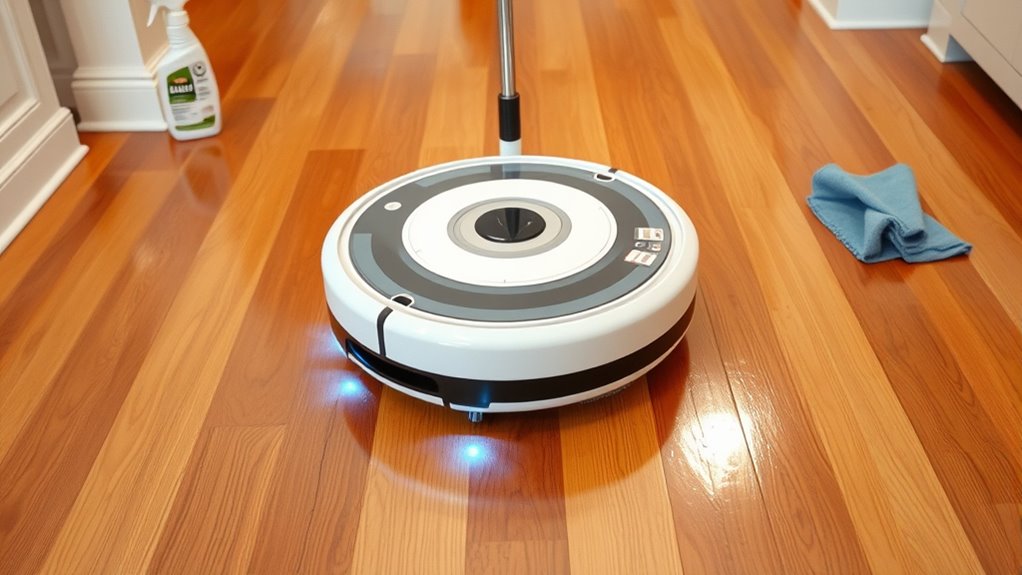
Safety and hygiene are central to the adoption of robot mops, as they are designed to improve cleanliness while minimizing risks for users and the environment. You benefit from reduced exposure to harmful chemicals and pathogens, making cleaning safer. Automated mopping lessens ergonomic strains and slip hazards, while proper maintenance prevents bacterial buildup. Additionally, safety standards ensure these devices meet environmental and chemical handling regulations. The market for cleaning robots, including robot mops, is experiencing rapid growth driven by increasing demand for efficient cleaning solutions. Consider these points: – They lower human contact with dangerous substances during cleaning. – Reduce risks of slips and repetitive strain injuries. – Use of UV or disinfectant features enhances surface sanitation. – Regular upkeep prevents bacterial growth in reservoirs. – They adhere to evolving safety and environmental regulations. Maintaining battery safety and proper sanitation practices is essential for optimal operation and user protection.
Market Trends and Consumer Adoption of Robotic Cleaners
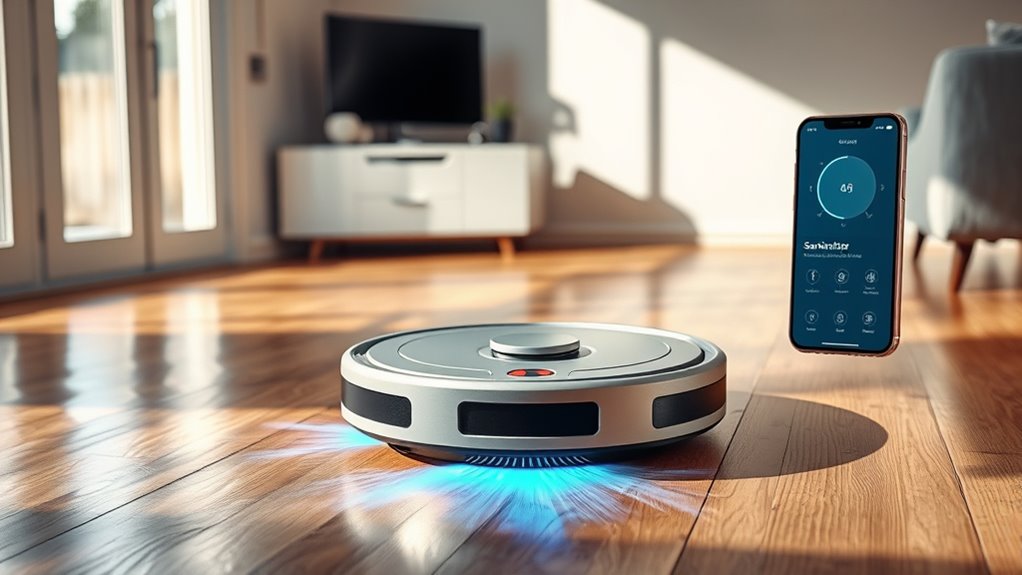
You’re likely noticing more robotic cleaners in homes as market growth accelerates driven by urbanization, rising incomes, and smart home trends. Consumer preferences are shifting toward hybrid mops with features like app control and voice compatibility, making these devices more convenient than ever. As technology advances and prices drop, adoption continues to expand across diverse demographics and regions. The market is expected to reach approximately $3 billion by 2025, reflecting strong consumer interest and ongoing innovation in product features.
Market Growth Drivers
The rapid growth of the robot mop market is driven by technological advancements and changing consumer lifestyles. As these devices become more capable, they appeal to busy households seeking convenience and hygiene. Improved features like hybrid vacuum-mop systems, smarter navigation, and adaptive water control enhance cleaning efficiency. Integration with smartphones, voice commands, and smart home systems makes operation seamless. Growing disposable incomes, especially in emerging markets, boost affordability and adoption. Post-pandemic health awareness elevates demand for effective sanitization, while consumers want multifunctional robots that handle dust and wet cleaning. Additionally, the commercial sector’s interest in autonomous solutions for high-traffic areas supports market expansion. Key drivers include:
- Advanced cleaning and navigation tech
- Increased health and hygiene focus
- Rising disposable incomes
- Convenience for busy lifestyles
- Commercial sector adoption
- Technological innovations continue to fuel ongoing market expansion.
- The development of tuning methodologies in automotive technology demonstrates how continuous improvements drive market growth.
Adoption in Smart Homes
How are smart home integrations transforming the way households adopt robotic mops? They make these devices more accessible and user-friendly through seamless connectivity, allowing you to control and schedule cleaning via voice assistants like Alexa or Google Home. Automated routines sync with your smart environment, keeping floors consistently tidy without manual effort. App-based monitoring offers real-time updates on cleaning status, mapping, and customization options. AI-driven navigation ensures efficient paths and obstacle avoidance, optimizing performance. As smart home adoption grows—69.91 million U.S. households in 2023—more consumers see robotic mops as essentials, especially with brands like iRobot and Roborock leading the way. The table below highlights key integration features:
| Feature | Benefit | Example Devices |
|---|---|---|
| Voice Assistant | Hands-free control | DEEBOT X2 OMNI, Dreame X40 Ultra |
| App Monitoring | Real-time updates | All major brands |
| Automated Routines | Scheduled cleaning | Ecovacs, iRobot |
| AI Navigation | Efficient, obstacle-free cleaning | Dreame X40 Ultra |
Additionally, advancements in filtration efficiency are improving the overall sanitation performance of robotic mops.
Consumer Preferences Shift
What’s driving this rapid shift in consumer preferences toward robotic cleaners? Several factors fuel this trend. You’re drawn to smarter, more efficient cleaning solutions that fit into busy lifestyles. The market’s growth reflects this, with the global robot mop segment expected to hit $3 billion by 2025. Consumer demands include:
- Advanced features like self-emptying docks and LiDAR navigation
- Hybrid vacuum/mop models for versatility
- Smart home integration through voice control and apps
- Increased availability via online and offline channels
- Rising adoption in emerging markets due to affordability and urbanization, which further accelerates market growth as more consumers seek accessible automation solutions.
As technology improves and prices decrease, more people see robotic cleaners as essential for maintaining hygiene and saving time. The market is projected to grow at a CAGR of 15% from 2025 to 2033, indicating a broader acceptance and reliance on automation in everyday cleaning routines.
Limitations and Challenges in Robotic Floor Sanitization
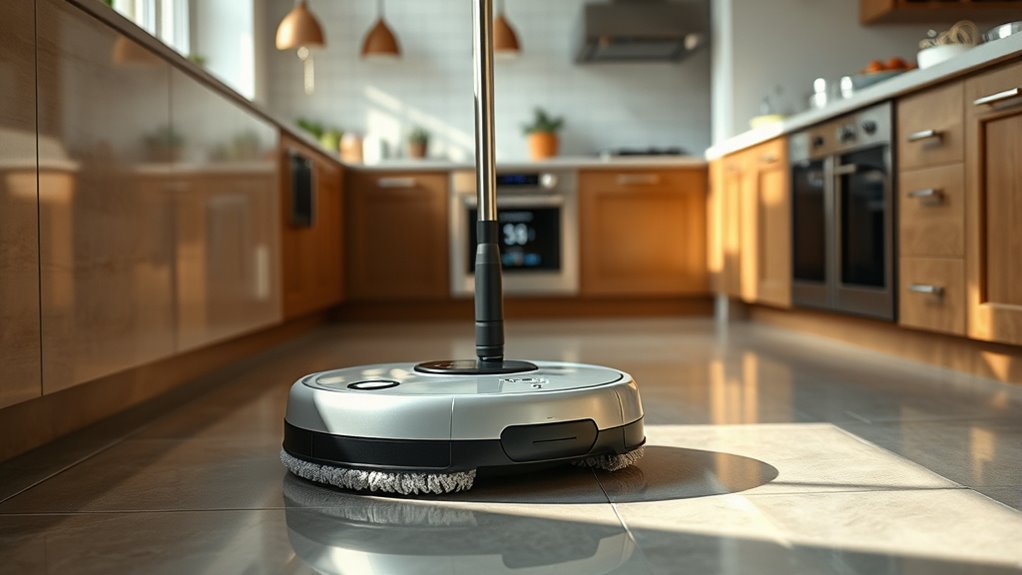
While robotic floor sanitizers have advanced considerably, they still face notable limitations and challenges that can affect their effectiveness. They lack the suction power needed to remove deeply embedded dirt and stains, especially on carpets or rugs. Their limited scrubbing ability makes tough stains or grout difficult to clean thoroughly. They’re generally ineffective on thick or heavily soiled carpets and can experience reduced efficiency over time without proper maintenance. Most don’t feature UV or chemical sanitization, relying instead on cleaning solutions with limited sanitizing properties, risking residue build-up and bacterial growth if not maintained properly. Navigation issues persist around complex furniture, tight spaces, or uneven surfaces, and navigation technology can significantly improve their obstacle detection capabilities. Additionally, high costs, ongoing maintenance, and hardware vulnerabilities can further hinder consistent, effective sanitization.
Future Developments in Robot Mop Technology
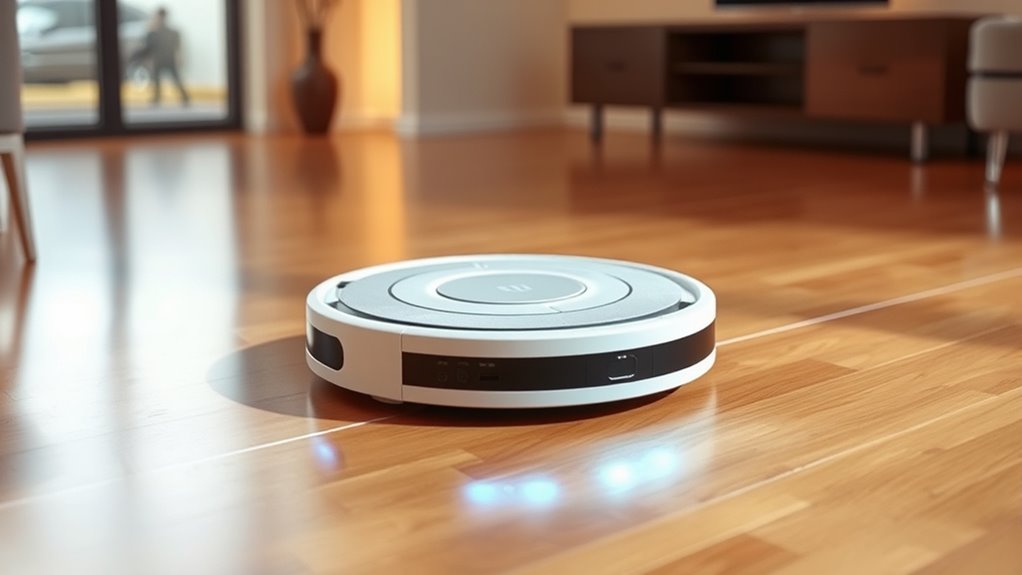
Future advancements in robot mop technology are set to revolutionize floor cleaning by introducing smarter, more efficient systems. Imagine a robot that self-washes and dries its mop pads, reducing manual maintenance, and guarantees hygienic, streak-free results during each pass. You’ll see innovations like ECOVACS’ OZMO™ ROLLER technology, combining high-pressure rotation with instant self-washing, preventing dirt transfer. Self-cleaning mechanisms minimize contamination, while heat-drying prolongs mop pad usability. These features work together to boost sanitation and cleanliness without your constant intervention. Additionally, AI and machine learning refine navigation, recognize dirtier zones, and adapt cleaning modes. Enhanced mapping with Lidar and sensors ensures thorough coverage, and autonomous docks handle debris, emptying and maintaining the system effortlessly. Future robots will be versatile, combining vacuuming and mopping into one sleek device for seamless, efficient cleaning. Advanced self-maintenance technology is increasingly being integrated to further reduce user involvement and enhance hygiene standards.
Frequently Asked Questions
Can Robot Mops Eliminate All Types of Bacteria and Viruses?
You ask if robot mops can eliminate all bacteria and viruses. While they effectively clean dirt and grime, most can’t fully sanitize surfaces because they lack disinfectant dispensing and precise heat control. Steam mops can kill some germs, but their uneven application limits effectiveness. UV-C light in specialized robotic disinfectors can kill many pathogens, but typical robot mops mainly focus on surface cleaning, not complete sterilization.
Do Robot Mops Disinfect Floors With Chemical Solutions or UV Light?
You might wonder how robot mops disinfect floors. They mainly use chemical solutions, applying diluted disinfectants via soaking pads or pre-spraying. UV light isn’t common in standard home robot mops but is used in specialized disinfection robots, especially in healthcare. Chemical solutions require proper application, while UV disinfection kills microbes through light exposure. Most robot mops focus on cleaning, with disinfecting often needing manual or UV-based methods.
How Often Should Robot Mops Be Maintained for Optimal Sanitation?
You might think your robot mop just works automatically, but for ideal sanitation, you should maintain it regularly. Clean the mopping pads after each use, check brushes weekly, and replace filters every few months. Wipe sensors and wheels weekly to prevent grime buildup. Frequent maintenance keeps your floors truly clean and the machine running smoothly, turning routine chores into a seamless process that safeguards your home’s hygiene.
Are Robot Mops Effective on All Floor Types and Textures?
You might wonder if robot mops work on all floors. They perform well on sealed hardwood, tiles, and stone, adjusting water and suction for each surface. However, they struggle with textured or uneven floors and avoid carpets to prevent damage. Advanced models use sensors to detect floor types, switching modes automatically. While effective on hard surfaces, they’re less reliable on soft or textured floors, so choose a model suited to your specific needs.
Do Robot Mops Reduce Cross-Contamination Risks During Cleaning?
Think of your floors as a battlefield, and cross-contamination as an unwelcome invader. Robot mops act like vigilant guardians, equipped with sensors that detect and avoid hazards like pet waste or dirt piles. They lift their pads when returning to their docks, preventing re-depositing contaminants. While not foolproof, these smart devices markedly reduce the spread of germs, making your cleaning routine safer and more effective.
Conclusion
As you watch a robot mop glide effortlessly across your floors, imagine a silent guardian tirelessly sweeping away dirt and germs. While it may not replace traditional cleaning entirely, its gentle hum and precise movements bring a new level of convenience and cleanliness. Embrace this modern marvel, knowing it’s quietly working behind the scenes, transforming your space into a pristine sanctuary—where spotless floors become the backdrop for your everyday moments.
